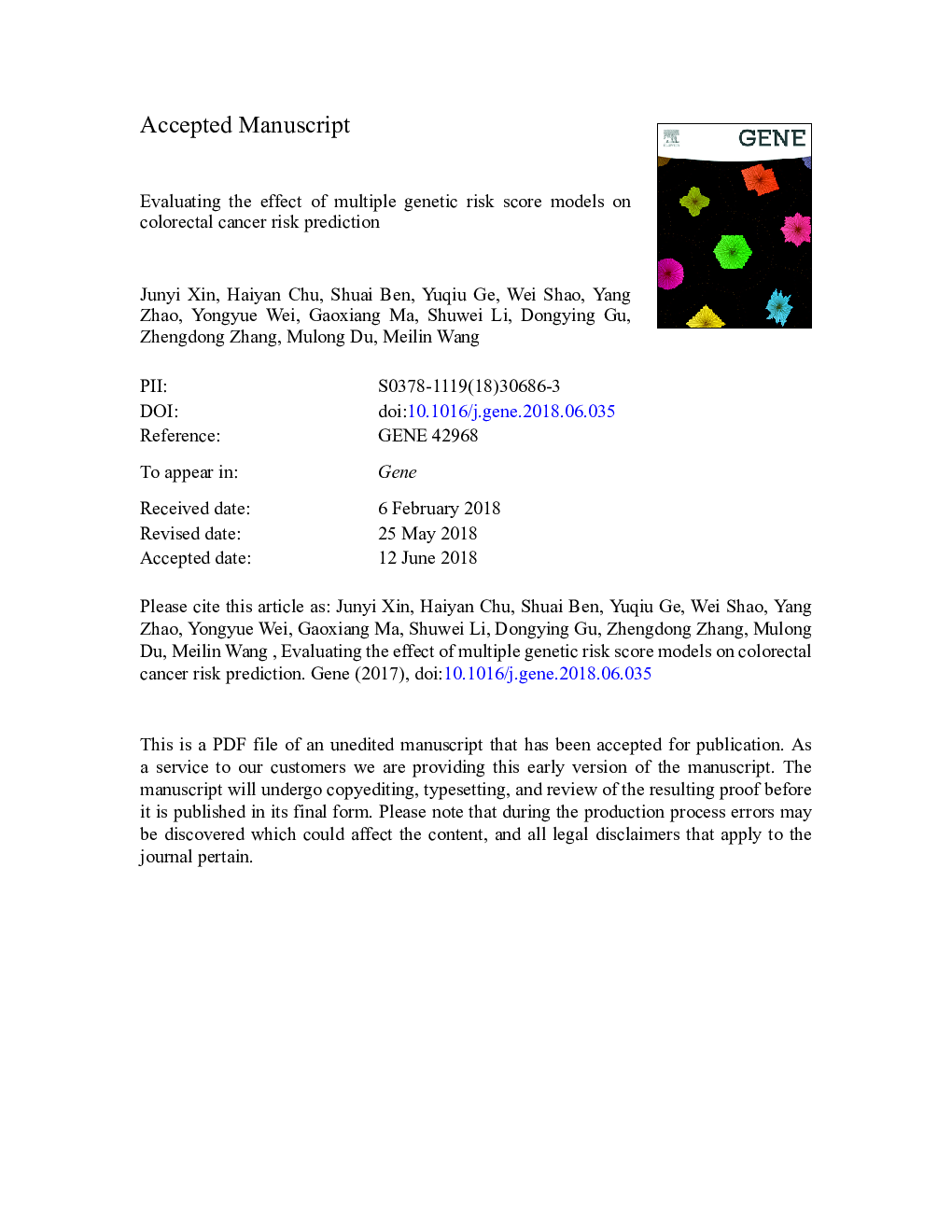| کد مقاله | کد نشریه | سال انتشار | مقاله انگلیسی | نسخه تمام متن |
|---|---|---|---|---|
| 8644600 | 1569763 | 2018 | 34 صفحه PDF | دانلود رایگان |
عنوان انگلیسی مقاله ISI
Evaluating the effect of multiple genetic risk score models on colorectal cancer risk prediction
ترجمه فارسی عنوان
ارزیابی اثر چند مدل نمره ریسک ژنتیکی بر پیش بینی خطر سرطان کولورکتال
دانلود مقاله + سفارش ترجمه
دانلود مقاله ISI انگلیسی
رایگان برای ایرانیان
کلمات کلیدی
HWEDatabase of Genotypes and PhenotypesdbGaPIDINRIGRsMAFAUC - AUCNet reclassification improvement - بهبود طبقه بندی خالصIntegrated discrimination improvement - بهبود یکپارچه تبعیضHardy-Weinberg equilibrium - تعادل هاردی-وینبرگColorectal cancer - سرطان روده بزرگbody mass index - شاخص توده بدنBMI - شاخص توده بدنیLinkage disequilibrium - عدم تعادل پیوستگیminor allele frequency - فراوانی آللی جزئیPredictive power - قدرت پیش بینی شدهgenome wide association study - مطالعه گسترده انجمن ژنومGWAS - مطالعهٔ همخوانی سراسر ژنومROC curve - منحنی ROCReceiver operating characteristic curve - منحنی مشخصه عملکرد گیرندهarea under curve - منطقه تحت منحنیgenetic risk score - نمره خطر ژنتیکیSingle nucleotide polymorphism - پلیمورفیسم تک نوکلئوتیدیRisk prediction - پیش بینی ریسکSNP - چندریختی تک-نوکلئوتیدCRC - کد افزونگی دورهای
موضوعات مرتبط
علوم زیستی و بیوفناوری
بیوشیمی، ژنتیک و زیست شناسی مولکولی
ژنتیک
چکیده انگلیسی
Currently, genetic risk score (GRS) model has been a widely used method to evaluate the genetic effect of cancer risk prediction, but seldom studies investigated their discriminatory power, especially for colorectal cancer (CRC) risk prediction. In this study, we applied both simulation and real data to comprehensively compare the discriminability of different GRS models. The GRS models were fitted by logistic regression with three scenarios, including simple count GRS (SC-GRS), logistic regression weighted GRS (LR-GRS, including DL-GRS and OR-GRS) and explained variance weighted GRS (EV-GRS, including EV_DL-GRS and EV_OR-GRS) models. The model performance was evaluated by receiver operating characteristic (ROC) curves and area under curves (AUC) metric, net reclassification improvement (NRI) and integrated discrimination improvement (IDI). In real data analysis, as DL-GRS and EV_DL-GRS models were carried with serious over-fitting, the other three models were kept for further comparison. Compared to unweighted SC-GRS model, reclassification was significantly decreased in OR-GRS model (NRIâ¯=â¯â0.082, IDIâ¯=â¯â0.002, Pâ¯<â¯0.05), while EV_OR-GRS model showed negative NRI and IDI (NRIâ¯=â¯â0.077, IDIâ¯=â¯â5.54Eâ04, Pâ¯<â¯0.05) compared to OR-GRS model. Besides, traditional model with smoking status (AUCâ¯=â¯0.523) performed lower discriminability compared to the combined model (AUCâ¯=â¯0.607) including genetic (i.e., SC-GRS) and smoking factors. Similarly, the findings from simulation were all consistent to real data results. It is plausible that SC-GRS model could be optimal for predicting genetic risk of CRC. Moreover, the addition of more significant genetic variants to traditional model could further improve predictive power on CRC risk prediction.
ناشر
Database: Elsevier - ScienceDirect (ساینس دایرکت)
Journal: Gene - Volume 673, 5 October 2018, Pages 174-180
Journal: Gene - Volume 673, 5 October 2018, Pages 174-180
نویسندگان
Junyi Xin, Haiyan Chu, Shuai Ben, Yuqiu Ge, Wei Shao, Yang Zhao, Yongyue Wei, Gaoxiang Ma, Shuwei Li, Dongying Gu, Zhengdong Zhang, Mulong Du, Meilin Wang,
